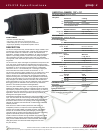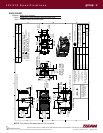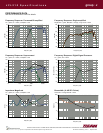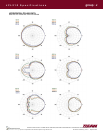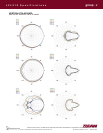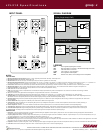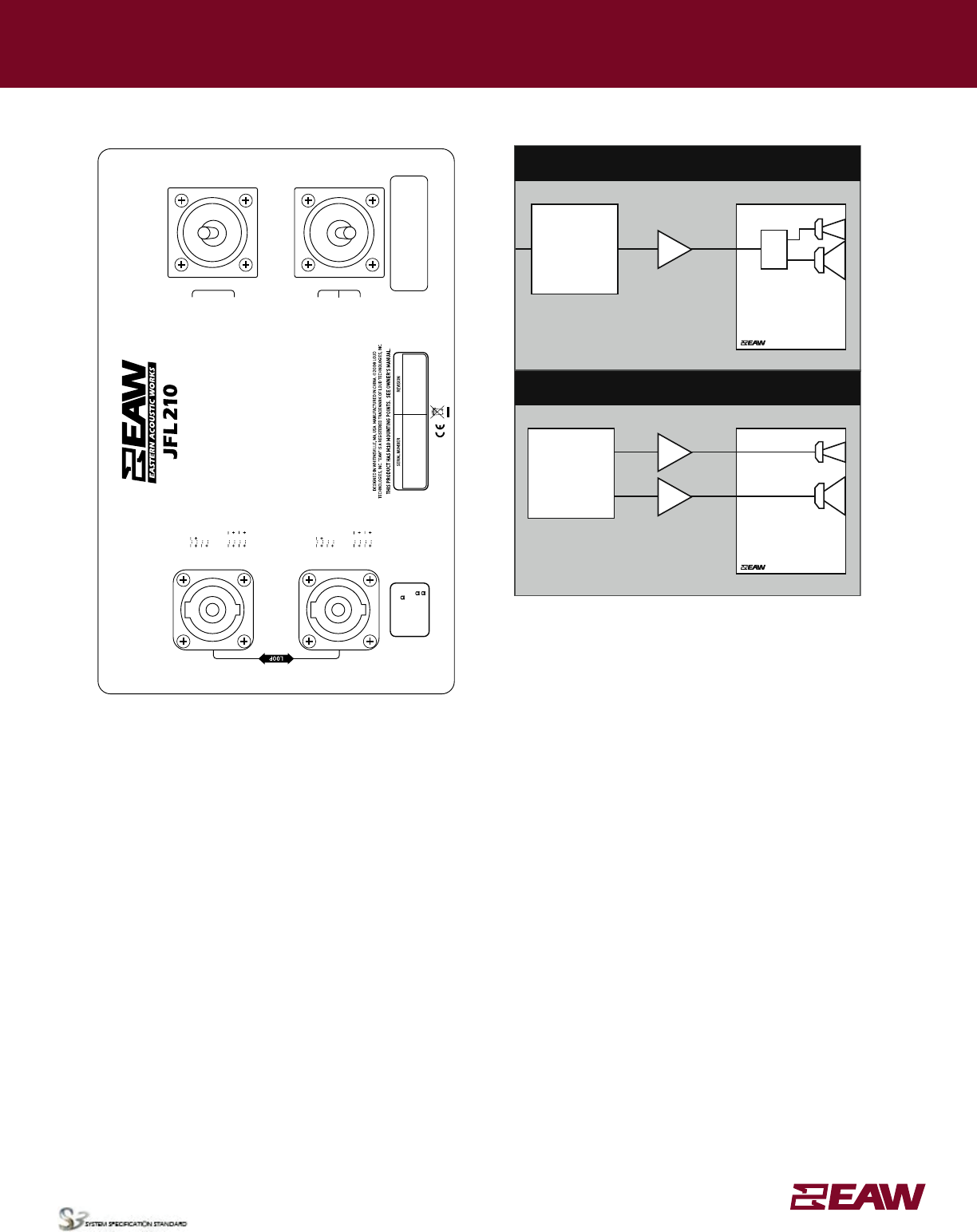
Eastern Acoustic Works • One Main Street • Whitinsville, MA 01588 • tel 800 992 5013 / 508 234 6158 • fax 508 234 8251 • www.eaw.com
EAW products are continually improved. All specifications are therefore subject to change without notice. Part Number: RD0480 (A) JFL210 September 2008
JFL210 Speci f i cations
group · J
NOTES
TABULAR DATA
1. Measurement/Data Processing Systems: Primary - FChart: proprietary EAW software; Secondary - Brüel & Kjær 2012.
2. Microphone Systems: Earthworks M30; Brüel & Kjær 4133
3. Measurements: Dual channel FFT; length: 32 768 samples; sample rate: 48 kHz; logarithmic sine wave sweep.
4. Measurement System Qualication (includes all uncertainties): SPL: accuracy +/-0.2 dB @ 1 kHz, precision +/-0.5 dB 20 Hz to 20 kHz, resolution 0.05 dB; Frequency: accuracy +/-1 %, precision +/-0.1
Hz, resolution the larger of 1.5 Hz or 1/48 octave; Time: accuracy +/-10.4 μs, precision +/-0.5 μs, resolution 10.4 μs; Angular: accuracy +/-1°, precision +/-0.5°, resolution 0.5°.
5. Environment: Measurements time-windowed and processed to eliminate room effects, approximating an anechoic environment. Data processed as anechoic or fractional space, as noted.
6. Measurement Distance: 7.46 m. Acoustic responses represent complex summation of the subsystems at 20 m. SPL is referenced to other distances using the Inverse Square Law.
7. Enclosure Orientation: For beamwidth and polar specications, as shown in Mechanical Specication drawing.
8. Volts: Measured rms value of the test signal.
9. Watts: Per audio industry practice, “loudspeaker watts” are calculated as voltage squared divided by rated nominal impedance. Thus, these are not True Watt units of energy as dened
by International Standard.
10. SPL: (Sound Pressure Level) Equivalent to the average level of a signal referenced to 0 dB SPL = 20 microPascals.
11. Subsystem: This lists the transducer(s) and their acoustic loading for each passband. Sub = Subwoofer, LF = Low Frequency, MF = Mid Frequency, HF = High Frequency.
12. Operating Mode: User selectable congurations. Between system elements, a comma (,) = separate amplier channels; a slash (/) = single amplier channel. DSP = Digital Signal Processor.
IMPORTANT: To achieve the specied performance, the listed external signal processing must be used with EAW-provided settings.
13. Operating Range: Range where the processed Frequency Response stays within -10 dB SPL of the power averaged SPL within this range; measured on the geometric axis. Narrow band
dips are excepted.
14. Nominal Beamwidth: Design angle for the -6 dB SPL points, referenced to 0 dB SPL as the highest level.
15. Axial Sensitivity: Power averaged SPL over the Operating Range with an input voltage that would produce 1 W at the nominal impedance; measured with no external processing on
the geometric axis, referenced to 1 m.
16. Nominal Impedance: Selected 4, 8, or 16 ohm resistance such that the minimum impedance point is no more than 20% below this resistance over the Operating Range.
17. Accelerated Life Test: Maximum test input voltage applied with an EIA-426B dened spectrum; measured with recommended signal processing and Recommended Protection Filter.
18. Calculated Axial Output Limit: Highest average and peak SPLs possible during the Accelerated Life Test. The Peak SPL represents the 2:1 (6 dB) crest factor of the Life Test signal.
19. High Pass Filter: This helps protect the loudspeaker from excessive input signal levels at frequencies below the Operating Range.
GRAPHIC DATA
1. Resolution: To remove insignicant ne details, 1/12 octave cepstral smoothing was applied to acoustic frequency responses and 1/3 octave cepstral smoothing was applied to the beamwidth and
impedance data. Other graphs are plotted using raw data.
2. Frequency Responses: Variation in acoustic output level with frequency for a constant input signal. Processed: normalized to 0 dB SPL. Unprocessed inputs: 2 V (4 ohm nominal impedance), 2.83 V (8
ohm nominal impedance), or 4 V (16 ohm nominal impedance) referenced to a distance of 1 m.
3. Processor Response: The variation in output level with frequency for a constant input signal of 0.775 V = 0 dB reference.
4. Beamwidth: Average angle for each 1/3 octave frequency band where, starting from the rear of the loudspeaker, the output rst reaches -6 dB SPL referenced to 0 dB SPL as the highest level. This method
means the output may drop below -6 dB SPL within the beamwidth angle.
5. Impedance: Variation in impedance magnitude, in ohms, with frequency without regard to voltage/current phase. This means the impedance values may not be used to calculate True Watts (see 9 above).
6. Polar Data: Horizontal and vertical polar responses for each 1/3 octave frequency band 100 Hz to 16 kHz or Operating Range.
INPUT PANEL SIGNAL DIAGRAM
LEGEND
DSP: User-supplied Digital Signal Processor.
HPF: High Pass Filter for crossover or Recommended High Pass Filter.
LPF: Low Pass Filter for crossover.
LF/HF: Low Frequency / High Frequency.
AMP: User-supplied Power Amplifier.
XVR: Passive LPFs, HPFs, and EQ integral to the loudspeaker.
AMP
2-Way, Single-Amp (LF/HF)
XVR
LF
HF
HPF
DSP
EQ
DELAY
HPF/LPF
AMP
2-Way, Bi-Amp (LF, HF)
AMP
HF
LF
JFL 210 = 24 KG / 5 2 LB
JFL 210 RIGG ING WOR KING LO AD LIMIT (WLL) : SIX (6)
JFL 210 IN S UCCES SION. 14 4 KG / 312 LB
FAILURE TO FOLLOW MANUFACTURER’S
INSTRUCTIONS CAN RESULT
IN DAMAGE, INJURY, OR DEATH.
BI-AMP
S IN G L E-AMP
PIN 1
PIN 1
PIN 2
PIN 2
PIN 1 LF
NC
NC
LF
PIN 1
PIN 2 HF
HF
PIN 2
BI-AMP
S IN G L E-AMP
PIN 1
PIN 1
PIN 2
PIN 2
PIN 1 LF
NC
NC
LF
PIN 1
PIN 2 HF
HF
PIN 2
SINGLE-AMP
BI-AMP
800W @ 8
LF: 800W @ 8
HF: 150W @ 8
HF SHADING
MULTI BOX
SINGLE BOX
LONG THROW
BI-AMP
SINGLE-AMP
OPERATING MODE



